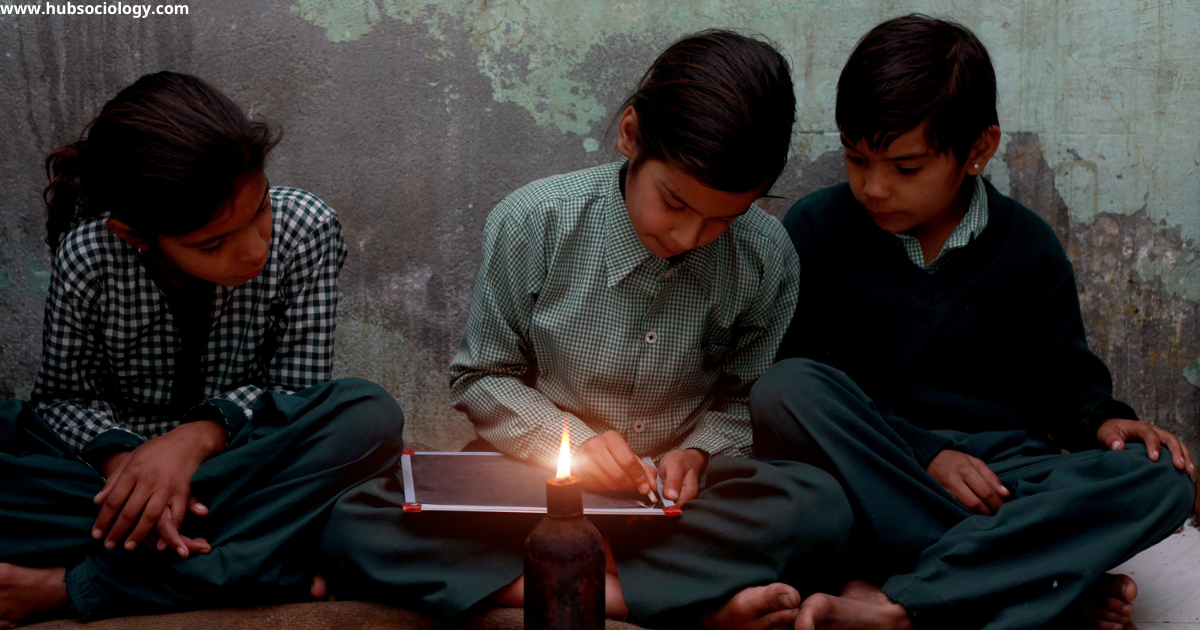Introduction on Trends and Patterns of Educational Attainment
Education plays a pivotal role in shaping human development and social progress. It serves as a foundation for economic growth, political participation, and social transformation. In India, the evolution of educational attainment—from literacy to higher education—reflects broader sociological processes such as modernization, social mobility, gender equality, and democratization. Over the decades, India has witnessed a remarkable transformation in educational access and participation, driven by state policies, globalization, and changing social values. However, disparities based on class, caste, gender, and region continue to influence the patterns of educational achievement.
This article explores the sociological dimensions of Trends and Patterns of Educational Attainment across four key levels: literacy, elementary education, senior secondary education, and higher education.

Table of Contents on Trends and Patterns of Educational Attainment
1. Literacy Trends in India
Literacy forms the first step in the educational ladder and is a crucial indicator of social development. According to the 2011 Census, India’s literacy rate stood at 74.04%, up from 64.8% in 2001. This steady increase demonstrates the success of literacy campaigns such as the National Literacy Mission (1988) and Saakshar Bharat (2009). The focus on adult literacy and female literacy has been central to reducing social exclusion and empowering marginalized groups.
Sociological Implications of Literacy:
- Social Inclusion and Empowerment: Literacy empowers individuals by enhancing their participation in community life and decision-making processes. It allows citizens to access information, rights, and opportunities, which is essential for social justice.
- Gender and Literacy Gap: While male literacy (82.14%) remains higher than female literacy (65.46%), the gap has been narrowing due to policy interventions like Beti Bachao Beti Padhao and the Sarva Shiksha Abhiyan (SSA).
- Rural-Urban Divide: Urban literacy rates (84%) surpass rural literacy (68%), indicating persistent geographical inequalities. Rural illiteracy often correlates with poverty, lack of infrastructure, and cultural attitudes toward formal education.
- Caste and Class Disparities: Scheduled Castes and Scheduled Tribes continue to lag behind due to historical disadvantages. Sociologists view this as a reflection of structural inequality embedded in India’s social system.
From a sociological perspective, literacy not only improves employability but also reshapes traditional hierarchies and power relations by fostering critical thinking and social awareness.
2. Elementary Education: Universalization and Challenges
Elementary education (Classes I–VIII) forms the foundation of a child’s cognitive, moral, and social development. The Right to Education (RTE) Act, 2009, marked a turning point by making free and compulsory education a legal entitlement for children aged 6–14 years. The Sarva Shiksha Abhiyan (SSA) and Mid-Day Meal Scheme have significantly increased enrollment rates and reduced dropout rates, particularly among girls and disadvantaged communities.

Trends in Elementary Education:
- Gross Enrollment Ratio (GER): The GER in primary education has reached near-universal levels (above 100%) due to widespread access and community mobilization.
- Gender Parity: The Gender Parity Index (GPI) has improved to almost 1.0 at the elementary level, indicating equal participation of boys and girls.
- Infrastructure Development: Expansion of schools in rural and tribal areas has improved accessibility. However, issues of quality persist, including teacher absenteeism and inadequate facilities.
Sociological Dimensions:
- Socialization Process: Elementary education introduces children to social norms, values, and discipline. Functionalist theorists like Emile Durkheim emphasize education’s role in integrating individuals into the moral fabric of society.
- Cultural Capital: According to Pierre Bourdieu, education transmits cultural capital, favoring middle and upper-class children who already possess linguistic and cognitive advantages.
- Social Mobility: Elementary education acts as a stepping stone for social mobility, particularly for lower-caste and rural children, helping them escape cycles of poverty and marginalization.
- Gender and Empowerment: Educating girls at the elementary level delays early marriage, improves health outcomes, and enhances women’s participation in the workforce.
Despite improvements, dropouts due to poverty, child labor, and socio-cultural barriers remain significant challenges. The quality of learning outcomes—rather than mere enrollment—has emerged as a central concern.
3. Senior Secondary Education: Expanding Horizons
Senior secondary education (Classes IX–XII) serves as a bridge between basic education and higher education or vocational training. The National Education Policy (NEP) 2020 emphasizes a holistic, flexible, and multidisciplinary approach at this stage, aiming to prepare students for both employability and higher studies.
Trends and Developments:
- Increased Enrollment: The GER at the secondary level has improved from around 52% in 2010 to over 77% by 2020, indicating greater retention beyond elementary education.
- Curriculum Diversification: Inclusion of vocational, technical, and skill-based subjects reflects the changing demands of a globalized economy.
- Private School Expansion: Urban areas have seen a surge in private schooling, creating a dual system of education where quality often depends on economic capability.
Sociological Analysis:
- Class Inequality: Access to quality senior secondary education is heavily influenced by socio-economic status. Middle- and upper-class families can afford private schooling and coaching, while poor families rely on underfunded public schools.
- Cultural Reproduction: Bourdieu’s theory of cultural reproduction applies strongly here—educational systems often reinforce existing social hierarchies rather than dismantle them.
- Gender and Education: Although girls’ participation has improved, social constraints such as early marriage, domestic responsibilities, and safety concerns continue to limit their educational progression in rural areas.
- Regional Disparities: States like Kerala and Tamil Nadu show high retention rates, while states such as Bihar, Jharkhand, and Uttar Pradesh lag behind due to poverty and infrastructural limitations.
Sociologically, this stage represents a critical turning point where educational attainment begins to reflect the intersectionality of class, gender, and regional factors.
4. Higher Education: Democratization and Challenges
Higher education includes colleges, universities, and technical institutes that prepare individuals for specialized careers and leadership roles. India has the third-largest higher education system in the world, with over 1,100 universities and 42 million students (AISHE, 2023). Yet, issues of equity, quality, and employability persist.
Trends in Higher Education:
- Gross Enrollment Ratio (GER): The GER in higher education increased from 8.1% in 2001 to 28.4% in 2023, reflecting growing aspirations for advanced learning.
- Privatization: Nearly 80% of colleges are privately managed, leading to commercialization and stratification in access and quality.
- Digitalization: The rise of online learning platforms (SWAYAM, NPTEL, and MOOCs) has expanded opportunities for lifelong learning and distance education.
- Globalization of Education: Cross-border education and international collaborations are reshaping Indian higher education to meet global standards.
Sociological Perspectives on Trends and Patterns of Educational Attainment
- Meritocracy vs. Inequality: While higher education is viewed as a path to meritocratic advancement, structural inequalities often determine who gets access to elite institutions.
- Gender and Representation: The share of women in higher education has improved significantly (around 49% in 2023), yet their presence in STEM and leadership roles remains limited.
- Caste-Based Discrimination: Reservation policies have opened doors for marginalized groups, but subtle forms of exclusion and prejudice persist within academic environments.
- Cultural and Intellectual Autonomy: Universities act as centers of critical thought and cultural transformation, but increasing politicization and commercialization threaten their democratic ethos.
From a sociological standpoint, higher education serves both as a vehicle for empowerment and as a site of social contestation—where power, privilege, and resistance interact dynamically.
Conclusion on Trends and Patterns of Educational Attainment
The trends and patterns of educational attainment in India—from literacy to higher education—mirror the country’s broader socio-economic transformations. Literacy and elementary education have achieved near universality, symbolizing progress toward inclusivity. However, disparities persist in senior secondary and higher education due to socio-economic, cultural, and gender-based inequalities. Sociologically, education acts as both a force of social mobility and a mechanism of social reproduction—shaping identities, redistributing opportunities, and redefining hierarchies.

As India continues to reform its educational landscape under the National Education Policy 2020, the challenge lies in ensuring not only access but also equality, quality, and critical awareness. Education must transcend economic utility to become a true instrument of human development and social justice—empowering every individual to participate meaningfully in the collective progress of society.
Do you like this this Article ? You Can follow as on :-
Facebook – https://www.facebook.com/hubsociology
Whatsapp Channel – https://whatsapp.com/channel/0029Vb6D8vGKWEKpJpu5QP0O
Gmail – hubsociology@gmail.com
Topic Related Questions on Trends and Patterns of Educational Attainment
5 Marks Questions on Trends and Patterns of Educational Attainment (Short Answer Type)
- Define educational attainment and explain its sociological significance.
- What are the major trends in literacy in India since independence?
- State any two sociological implications of literacy.
- What is the importance of elementary education in the process of socialization?
- Mention two main features of the Right to Education (RTE) Act, 2009.
- Highlight the major causes of gender disparity in education.
- Write a short note on the rural-urban divide in literacy rates.
- What is the Gross Enrollment Ratio (GER), and why is it important in educational studies?
- State two challenges faced by higher education institutions in India.
- How does education promote social mobility in society?
10 Marks Questions on Trends and Patterns of Educational Attainment (Medium Answer Type)
- Discuss the main trends and patterns of literacy in India from a sociological perspective.
- Examine the role of the Sarva Shiksha Abhiyan (SSA) and Mid-Day Meal Scheme in promoting elementary education.
- How does social class influence educational attainment at the senior secondary level?
- Explain how gender and caste impact access to higher education in India.
- Evaluate the role of education in reducing social inequalities in India.
- Discuss the major challenges in achieving universal elementary education.
- How has privatization affected the quality and accessibility of senior secondary education in India?
- Explain Pierre Bourdieu’s concept of cultural capital and its relevance to educational inequality.
- Discuss the sociological importance of literacy in promoting democratic participation.
- Analyze the major provisions of the National Education Policy (NEP) 2020 related to educational attainment.
15 Marks Questions on Trends and Patterns of Educational Attainment (Long Answer / Essay Type)
- Examine the trends and patterns of educational attainment in India across different stages—literacy, elementary, senior secondary, and higher education—from a sociological perspective.
- Discuss how education acts as both a mechanism of social mobility and a tool for social reproduction in Indian society.
- Critically analyze the impact of socio-economic, gender, and regional disparities on educational attainment in India.
- Evaluate the progress of India’s educational policies (1968, 1986, 2020) in shaping literacy and higher education outcomes.
- How does the structure of the Indian education system reflect broader patterns of inequality in society?
- Discuss the role of higher education in the context of globalization and digital transformation in India.
- Examine the functional and conflict perspectives of education with reference to current educational trends in India.
- Analyze the challenges and opportunities of universalizing secondary and higher education in the 21st-century sociological context.
- Explain the role of education in empowerment, modernization, and nation-building in India.
- Discuss how the National Education Policy (NEP) 2020 aims to transform patterns of educational attainment in a sociologically inclusive manner.
